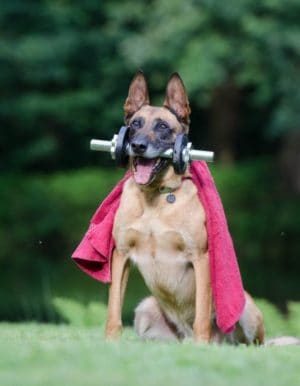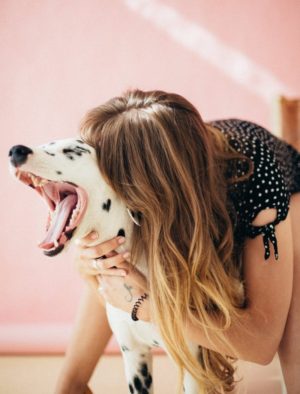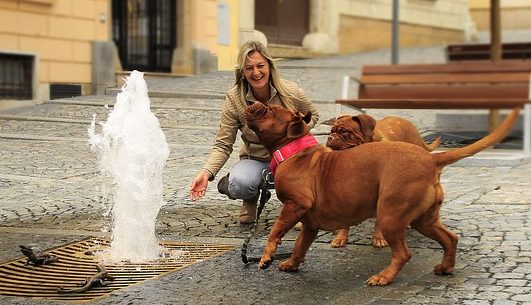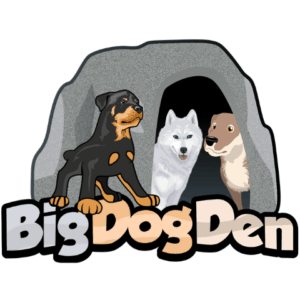If you’re looking for a dog to be your life-long companion, you’ll want to consider more than the looks of the dog. I’ve always loved big dogs and wondered if they were smarter. I know they’re loyal but was curious to know if they were MORE loyal.
One of the questions also may have asked yourself in the process of acquiring a big dog companion is likely, “Are Big Dogs more intelligent and more loyal (than smaller dogs)?”
Yes! *Big Dogs are among the top breeds in train-ability, indicating their intelligence level to be higher than most, but not all, small dogs. In regard to loyalty, the findings weren’t as clear-cut. There is no solid evidence that Big Dogs are more loyal than small dogs, both because there is no “test” for loyalty and humans have varying definitions of the word. *According to AKC standards
BUT…
Because the internet has a lot of conflicting information, I decided to go with the most trusted source (in my opinion) for the statistics to base my decision upon, The American Kennel Club (AKC). Formed in 1884, the AKC is a leading authority in all things “dog”.
I’m excited to share my findings with you, so let’s “chew on” the information I gathered! In this article, you’ll discover:
- Which Dogs Scored Highest in Train-ability and Intelligence
- How Intelligence in Dogs is Determined
- When to Begin Training Your Big Dog To Best Utilize His Intelligence
- How to Cultivate Loyalty in Your Big Dog
- What Big Dogs Need to be Healthy, Intelligent and Loyal
Top 10 Dog Breeds in Intelligence
Most dog owners think their dog is the “smartest dog ever” and perhaps, to them the statement is true! However, there are some statistics that may differ from the dog owner’s opinion.
The AKC has compiled a list of the most trainable dog breeds, and we can ascertain that train-ability and intelligence go hand in hand! Here are the results, including the breed’s average adult height and weight:
- Border Collie: Height 18-22 inches (46-56cm)/ Weight 40-65 pounds (18-29kg)
- Poodle: Height 18-24 inches (45-60cm)/ Weight 45-70 pounds (20-31kg)
- German Shepherd Dog (GSD): Height 22-26 inches (55-65cm)/ Weight 49-88 pounds
- Golden Retriever: Height 20-24 inches (51-61cm)/ Weight 55-75 pounds (22-34kg)
- Doberman Pinscher: Height 24-28 inches (61-72cm)/ Weight 71-99 pounds (32-45kg)
- Shetland Sheep Dog: Height 13-16 inches (33-41cm)/ Weight 14-27 pounds (6-12kg)
- Labrador Retriever: Height 22-24 inches (55-62cm)/ Weight 55-80 pounds (24-36kg)
- Papillon: Height 8-11 inches (20-28cm)/ Weight 7-10 pounds (3-4.5kg)
- Rottweiler: Height 22-27 inches (56-69cm)/ Weight 77-130 pounds (35-60kg)
- Australian Cattle Dog: Height 17-20 inches(43-51cm)/ Weight 31-35 pounds (14-16kg)
Of the ten breeds listed, 7 weigh more than 40 pounds (about 18kg) on average in their adulthood. One weighs from 20-40 pounds (9-18kg), and two breeds weigh under 20 pounds (9kg). I’m seeing a trend, aren’t you? Just to make doubly sure, I did look at three more “top 10 in intelligence” dog breed lists only to find them (almost) identical. I can only conclude that Big Dogs are more trainable than MOST (but not all) smaller breeds.
FYI: Generally, adult females tend toward the lower end of the weight range and males, toward the higher.
How is Intelligence Measured in Big Dogs?

According to psychology professor Stanley Coren, canine intelligence can be broken down into three categories:
- Instinctive Intelligence: This is the kind of intelligence dogs are born with, according to their breed. Rottweilers, for example, were born and bred to herd other animals. His natural ability to perform this task is a measure of his instinctual intelligence.
- Obedience Intelligence: In this category, dogs score by carrying out complex commands made by his master or trainer.
- Adaptive Intelligence: A dog’s ability to learn from his environment and to problem solve on his own is an indicator of his intelligence level. If you’ve ever seen a dog escape from an enclosed yard or figure out how to open the cabinet door that houses his treats, you’ve seen adaptive intelligence in action!
Because dogs are “pack animals” it’s important to understand that their intelligence level is measured according to this “pack mentality” and not necessarily measured by how well they lean and follow commands issued by humans. Put simply, dogs just think differently than we do.
Can You “Test” Your Big Dog’s Intelligence?
You absolutely can! Although this testing won’t provide any scientific “numbers” to add to your Big Dog’s pedigree, there are some simple tests that will give you a general idea of your dog’s cognitive abilities, and give you a starting point for training.
To begin, start with these 3 Quick and Easy Intelligence Tests:
- The “Escape” Test: Place a light-weight town or cloth completely (and gently) over your dog’s head. Count how many seconds it takes him to “escape”. A highly intelligent dog will free himself from the “capture” in less than 30 seconds. Medium intelligence will have him free in 31-120 seconds. Low intelligence is indicated if it takes longer than 120 seconds to get free or the dog doesn’t try at all.
- The “Hide a Treat” Test: Let your dog see you hide a treat under a towel or small piece of cloth. Count the seconds it takes him to “find” the treat. Success in under 30 seconds displays a high intelligence level. 31-60 seconds indicates medium intelligence. More than 60 seconds or failure altogether is indicative of a lower intelligence level.
- The “Puzzle Toy” Treat Dispenser: This test is just the natural progression of the “Hide a Treat” test. There are amazing puzzle toys available that instantly reward your dog with a treat for solving the puzzle. These toys are also a way to train your dog to do better at “puzzles” and provide hours of fun while the dog learns!
SEE TOP INTERACTIVE TOYS FOR LARGE DOGS FROM AMAZON
Training Your Big Dog to Maximize His Intelligence
The time to begin training your Big Dog is the day after his arrival in your home. The first things you’ll want to introduce him to is where he’ll be expected to sleep, eat, and use the bathroom.
TRAINING TIP: Teach your new puppy his name very soon after bringing him home. Incorporate teaching his name along with the next step.
When you see comfortable progress with these points, you’ll begin teaching the 5 Basic Commands:
- Come: Calling your dog to you.
- Heel: Teaching your dog to walk alongside you, without lunging or pulling away.
- Down: Quelling your dog’s desire to jump on you (or others).
- Sit: Self-explanatory.
- Stay: Training your dog little by little to remain in his current position even as you walk away.
I strongly recommend you enroll your Big Dog in obedience classes! With some careful shopping around, you can find a 6-8 week session that is relatively inexpensive. be ever aware that your cute little fuzzy puppy is going to grow into a VERY Big Dog!
The time to get the upper hand in good behavior training is sooner, rather than later. Of course, you CAN provide this training yourself at home, just understand that it takes a lot of time, patience, and dedication on your part. Additionally, obedience classes are a fantastic way to introduce your dog to the concept of socialization!
Build a Strong Relationship, Teach Obedience, Increase Intelligence, AND HAVE FUN!
Are Big Dogs Naturally Loyal?

To a degree. A Big Dog that is treated with kindness and cared for by a human will develop a bond with that human almost immediately. This bond is the “birth” of any future loyalty the dog will display. The great news is that the bond that happens naturally between you and your Big Dog can be nurtured and strengthened with every interaction you have together. Walks, playtime, training, and grooming can all be utilized as bonding time!
Here at Big Dog Den, you’ll find a treasure-trove of information to improve the quality of your bonding, which will, in turn, improve the level of your dog’s loyalty! After you’re through with this article, you’ll want to check out two more that will take your bond with your Big Dog to a deeper level, and his loyalty to a higher level.
Grooming Your Dog (with a Bonus Mini-Massage Manuel)
Please Note: Both the articles above are written from Rottweiler owner’s perspective, but certainly are applicable to all Big Dogs!
You should also know…
What a Big Dog Needs to Be Intelligent & Loyal
All dogs require your time and attention to be healthy, intelligent, and loyal. Big Dogs are no exception to this rule! The more of your time and attention they receive, the better behaved and well-rounded in personality they will be. Establish this as their primary need, but don’t neglect the other factors that will influence your Big Dog’s overall well-being and personality. These factors include:
- A Balanced and Nutritious Diet (Including Hydration)
- Sufficient and On-Going Training
- Plenty of Exercising and Fresh Air
- Frequent and Regular Opportunities for Socialization, Both with Other Animals and Other Humans
- Regular Health Care and Check-Ups from a Veterinarian

It is my sincerest desire for you to have a lifetime of love, enjoyment, and devotion with your Big Dog! I hope today’s article has helped shine some light on how intelligence and loyalty come into play for the “bigger picture” of the relationship you’ll have with your beloved companion.
Although your Big Dogs intelligence level has no bearing on the love you’ll come to feel for him (or her!) it’s a good indicator of the level to which you’ll be able to train him and will help you set reasonable expectations. And please never forgot that loyalty comes in the form of a bond between canine and human. I’ll “see you” the next time you stop by the Big Dog Den!
*This article has been reviewed in accordance with our editorial policy.

